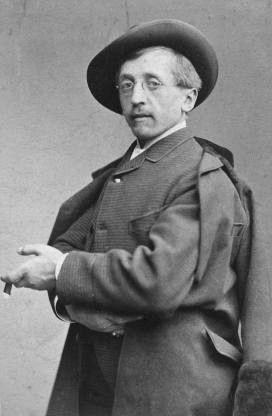
The world recently celebrated the 148th birthday of Wassily Kandisky, often called the father of abstract art. However, not many people know that this legendary Russian painter once had a Slovenian art teacher named Anton Ažbe.
Ažbe was born in 1862 in the small village of Dolenčice in Slovenia’s Poljane Valley, not far from the medieval town of Škofja Loka. Orphaned at a young age, he spent much of his childhood in a foster family. Because he was small and weak, and had a bent back, he was trained to work in a grocery store. However, he ran off and began to hang out with artists. It turned out that he had a talent for painting and he eventually enrolled at the Art Academies in Vienna and Munich. There, he was introduced to the latest trends and theories in European art.
In addition to being a skilled painter, Ažbe was also a gifted evaluator of other artist’s creations and was often asked to give his input on various works. In 1893, he opened his own school in the Bavarian capital. For more than a decade, he taught students from across Europe, including Rihard Jakopič, Ivan Grohar, Wassily Kandinsky, Mstislav Dobuzhinsky, and Nadežda Petrović.
Ažbe was known as a demanding teacher, and his students would spend hours studying the intricacies of the human figure. Nevertheless, he preached the primacy of the artist’s vision, and was remembered for his saying: “Know your anatomy but forget it in front of your easel.” He urged his students to focus on “the main line” rather than insignificant details, and developed the “ball principle” to help his students master the lighting of human faces. According to some art historians, the theories developed by Ažbe strongly influenced the interplay of color in Kandinsky’s abstract art many years later.
Little is known about Ažbe’s private life. He never married and had the reputation of a lonely eccentric. His slow, awkward walk caused him to be teased by children, and he was even ridiculed by Munich cartoonists. He slept in his studio and would often go on drunken binges in neighborhood beerhalls.
Still, he was well-liked by his students, many of whom he trained free of charge. Kandinsky described him as a “gifted artist and an uncommonly good person,” and in 1903, he was given a medal by the government of Serbia. Ažbe wasn’t a prolific painter, but some of his works – such as “Negress” (Zamorka), a profile of a black woman – have become classics and are now exhibited at the National Gallery in Ljubljana.
Anton Ažbe died of cancer in 1905. While he never strayed far from realism and did not embrace the avant-garde, his legacy lived on in his students, several of whom eventually came to shape the face of 20th century art.

































































